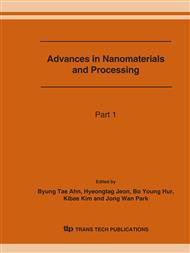p.49
p.53
p.57
p.61
p.65
p.69
p.73
p.77
p.81
Etching Mechanism of ZnO Thin Films in Inductively Coupled Plasma
Abstract:
The etching properties of the ZnO thin films in the inductively coupled Cl2/Ar plasma (ICP) were studied in the terms of etch rate and selectivity as functions of gas mixing ratio, ICP coil power and dc bias voltage. The maximum etch rate of 129.3 nm/min was obtained for the mixture of 20% Ar/80% Cl2. The X-ray photoelectron spectroscopy (XPS) analyses of the ZnO surfaces etched at various Cl2/(Cl2+Ar) mixing ratios revealed the formation of the ZnClx and ClOx reaction by-products as a result of the increased etch rate with increasing Cl2 addition, compared with 100% Ar+ sputter etching. From the analysis of these data, it was proposed that the maximum on the etch rate may be explained by the concurrence of chemical and physical pathways in the ion assisted chemical reaction.
Info:
Periodical:
Pages:
65-68
Citation:
Online since:
June 2007
Authors:
Keywords:
Price:
Сopyright:
© 2007 Trans Tech Publications Ltd. All Rights Reserved
Share:
Citation:


